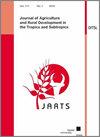鼠伤寒沙门氏菌攻击本地和外来火鸡体重和生理反应的基因型差异
Q3 Social Sciences
Journal of Agriculture and Rural Development in the Tropics and Subtropics
Pub Date : 2021-11-02
DOI:10.17170/KOBRA-202110274960
引用次数: 2
摘要
为了更好地了解当地适应的火鸡对沙门氏菌病的易感性和/或耐受性,我们比较了受沙门氏菌感染的火鸡的体重、抗体滴度和基于基因型和性别的生理特征。来自两种基因型(160只本地火鸡和140只外来火鸡)的300只火鸡被饲养了20周。每周测量体重(BW)、直肠温度(RT)、脉搏率(PR)和呼吸频率(RR)。在第8周和第13周接种前后,从每只火鸡身上采集血样,用酶联免疫吸附测定法检测血清抗体。基因型对所有测量的参数都有显著影响(p<0.05)。尽管受到鼠伤寒沙门氏菌的挑战,但外来火鸡的体重高于本地火鸡,而两性异形有利于火鸡。除第2周、第6周和第8周外,外来火鸡的RT显著较高(p<0.05)。同样,除了第4周(204.28±2.48次/分)和第8周(216.98±1.46次/分。RR也遵循相同的趋势,而在第2周(1.53±0.06次呼吸/分钟)和第14周(1.17±0.07次呼吸每分钟),外来火鸡的HSI更高(p<0.05)。接种前和接种后,当地火鸡对沙门氏菌的抗体较高(p<0.05),而两种基因型的母鸡在接种后第7天的抗体滴度均较高(p<0.05)。目前的结果似乎不足以令人信服,表明对沙门氏菌感染的耐受性/易感性存在差异,因此这两种基因型可能具有同等的适应性。本文章由计算机程序翻译,如有差异,请以英文原文为准。
Genotypic differences in body weight and physiological response of local and exotic turkeys challenged with Salmonella typhimurium
To better understand susceptibility and/ or tolerance of locally adapted turkey to salmonellosis, we compared bodyweight, antibody titres and physiological traits based on genotype and sex of salmonella -infected turkeys. Three hundred poults from two genotypes (160 local and 140 exotic turkeys) were raised for twenty weeks. Bodyweight (BW), rectal temperature (RT), pulse rate (PR) and respiratory rate (RR) were measured weekly. Blood samples were collected from each turkey before and after inoculations at week 8 and 13 for serum antibody detection using enzyme-linked immunosorbent assay. Genotype had a significant (p < 0.05) effect on all the parameters measured. Exotic turkey had higher weight than local while sexual dimorphism was in favour of toms despite challenge with Salmonella typhimurium . The RT was significantly higher (p < 0.05) in exotic turkeys except at week 2, 6 and 8. In like manner, PR was higher (p < 0.05) in exotic turkey except at week 4 (204.28±2.48 beats/minutes) and 8 (216.98±1.46 beats/minutes) where it was higher in local turkey. RR also followed the same trend while HSI was higher (p < 0.05) in week 2 (1.53±0.06 breaths/minutes) and 14 (1.17±0.07 breaths/minutes) in exotic turkeys. Local turkeys had higher (p < 0.05) antibodies against Salmonella organisms before and after inoculation while the hens of both genotypes had higher (p < 0.05) antibody titres at the 7 th day after inoculations. The present results seemed not to be convincing enough to suggest differences in tolerance/susceptibility to Salmonella infection and therefore the two genotypes may be equally adapted.
求助全文
通过发布文献求助,成功后即可免费获取论文全文。
去求助
来源期刊
CiteScore
2.30
自引率
0.00%
发文量
0
审稿时长
>36 weeks
期刊介绍:
The Journal of Agriculture and Rural Development in the Tropics and Subtropics publishes papers dealing with original research and review papers in the fields of plant production, animal nutrition and animal husbandry, soil science, rural economy and farm management, forestry and forest economy, veterinary hygiene and protection against epidemics.

 求助内容:
求助内容: 应助结果提醒方式:
应助结果提醒方式:


